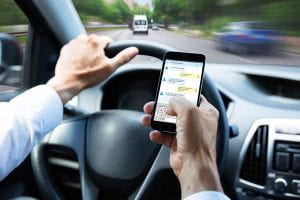 More than 42,000 people died in traffic accidents in 2021, the most in 16 years, according to data released this month by the National Highway Traffic Safety Administration (NHTSA).
More than 42,000 people died in traffic accidents in 2021, the most in 16 years, according to data released this month by the National Highway Traffic Safety Administration (NHTSA).
One of the contributing factors to this rise in deaths was an increase in impaired or distracted driving, which contributed to at least 3,500 traffic-related deaths. This number is likely underreported because distracted driving is difficult to identify during crash investigations.
While this is a problem that involves everyone, young people are disproportionately at fault. Drivers aged 18 to 34 are more likely to die in distraction-affected crashes than any other age group, according to NHTSA data.
Fortunately, research helps explain what’s happening when drivers become distracted. There are three ways people become distracted while driving, according to data from the U.S. Centers for Disease Control and Prevention: taking their eyes off the road, taking their hands off the wheel, or taking their mind off of driving by thinking about something else.
A 2018 systematic review found that any mode of conversation—whether using a handheld phone, a hands-free device, or conversing with a passenger in the car—led to a reduction in driving performance. The review, published in the journal Human Factors, included 93 studies with more than 4,300 participants.
Researchers found that most drivers conversing on a cellphone while driving compensated for their distraction by reducing their speed and leaving more space for vehicles in front of them. The review also found that dialing a phone led to greater reductions in performance compared to simply talking, and therefore was much more dangerous. One takeaway: If you are planning to have a phone conversation while driving, dial before you begin your trip.
A more recent study published by researchers in China last year looked at the effect of voice-activated, hands-free driving apps on youth drivers. Their experiments found that these apps significantly weakened the performance of young drivers. Specifically, young drivers using these apps were more likely to drift from side to side within their lane, had slower response time (especially when a traffic light changed color), and were more likely to experience a collision.
There are a lot of data that suggest phones lead to unsafe interactions while we are traveling. What can we do about it? A systematic review found that mindfulness training may be a helpful solution.
Researchers analyzed 17 studies that looked at whether having a mindful mentality improved driving behavior, and whether specific mindfulness interventions could help. They found that when a driver’s mind wanders, they are more likely to overlook hazards, make mistakes, and increase their risks of having a collision. They found some limited evidence that mindfulness exercises before or while driving, such as taking slow deep breaths, may help drivers stay focused and avoid using mobile or hands-free devices while driving. More research is needed to ensure that these strategies actually work.
The take-home message: Anything that takes your mind off the road while driving increases the chances you’ll make a mistake and get involved in a collision. This is especially true for new drivers and young adults. The best strategy to avoid distracted driving is to make a concerted effort to stay in the moment and pay attention to your surroundings.


